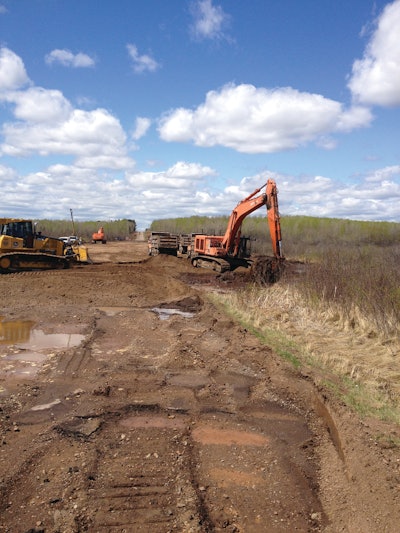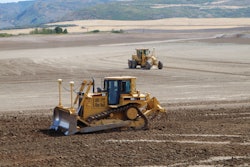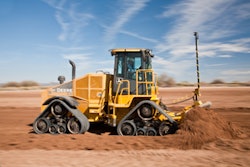
Automated grade control can benefit diverse contractors of all sizes, not just large earthmoving contractors. But you need to understand how to apply the technology and you’re acquisition options.
Rochester, NY-based Frederico Construction and Demolition handles projects ranging from site development and road construction to utility installation and building demolition. Approximately 75% are site-related work, with demolition accounting for the remaining 25%.
The family business traces its roots back to 1967. “My brother and me took ownership in 2007 and renamed it Frederico Construction and Demolition because we were doing both scopes of work and wanted construction and demolition in the name of the company,” says Lee Frederico. The company completes $5 to $6 million a year in total volume with approximately 25 employees in the field.
Diversity helped the company navigate these tumultuous economic times, but it requires a different approach to investing in technologies. “A company as diverse as us, it doesn’t make sense for us to own a GPS grade control system. We don’t do enough site work to utilize that system on a bulldozer every single day of the week.”
But the company still found a way to take advantage of 3D grade control. “We rent,” says Frederico. “We have a good dealer locally, there is no need to purchase a system. We line our projects up so we can go in and rent from our local Topcon dealer, Admar Supply.”
Frederico either rents a complete machine from Admar or it rents the just the Topcon 3D MC2 and plugs it into the appropriate John Deere dozer. “John Deere dozers currently come plug and play ready,” says Frederico. “So we can get any size dozer from John Deere, from a 650 to an 850, and everything is pre-wired, pre-plugged.” The unit rented from Admar can be mounted to the machine within five minutes. “All of the brackets and everything that you need are in place. You localize the site and you are working in a matter of two hours.”
The company does own and utilize a GPS base station and rover that has come in handy for multiple tasks. “We use it on demolition and site projects,” says Frederico. “You can localize a demolition project to quantify a concrete foundation for removal. We do as-built drawings for site projects. We do our own layout. Now that we have this tool, we are learning more things that it can do and we are bringing it into both sides of our company. So we are definitely getting use out of the GPS every day.”
While Frederico would like to own an automated grade control system, his decisions are driven by economics. “It’s a challenging economy. You have to think about every purchase and every move ten times before you do it. You have to be very cautious.”
For example, last season the company rented an automated grade control system for its dozer for five months. “This year I have yet to need one,” says Frederico. “For a small contractor like us, a $100,000 investment is big. It is buying another excavator or replacing a dump truck. Or it is buying another bulldozer. Those items work every day, all day. If we owned grade control we would have yet to have it on a machine this year, and it is July. I would never buy an excavator for $100,000 to just park it in the yard for seven months.”
The size and nature of a specific job determines if it is a candidate for automated grade control. The company has three approaches to grade control depending upon the size of the project. They use a surveyor to set stakes, they can use the GPS and rover or they can use the GPS in conjunction with automated grade control.
The cost of building a 3D model for a project must be considered. “It costs about $2,500 to build a 3D model for a project,” says Frederico. “So I have to weigh the cost of a surveyor to lay out the job in comparison to that $2,500.” With larger sites where surveying costs can reach $20,000, the decision is easy. On smaller projects it can be more difficult. “When there is $3,000 of surveying on a project, even if you build the model and set up the GPS, there is still some surveying required. You have to set the bench marks and go out and localize, verifying the control on the site. There is always a survey expense on a project, even with GPS.”
Labor savings accounts for the largest share of the return on investment. “You send one operator out with a bulldozer to do the grading and earthwork that used to take one operator and two laborers,” says Frederico.
But there is also a savings in materials. The machine cuts a perfect sub-grade elevation. “When you are placing stone, that is a savings,” says Frederico. In addition, placing the stone used to be a five person operation. “Now it is a two-person operation. You have a guy in a bulldozer and a guy on a roller.”
The labor savings is very important to Frederico. “Good labor is really hard to find right now. Not many people enjoy being out in the dust and dirt. When you can send one or two people that used to be four or five, it makes it easier to manage your company.”
Frederico considers GPS technology critical to future success. “GPS isn’t the future anymore, it is the here and now. Every contractor should embrace it, become exposed to it and try to learn the technology. It will change the way that you do business.”
Working in a diverse environment
Superior, WI-based RJS is a family of companies that offers a range of services from highway and site development to landfills, waste water treatment, aggregates supply and even shipyard services.
Two GPS base stations and rovers are used across the family of companies. On highway projects Eric Altman, the surveyor, uses the rover to check grades. In the quarry the system is used for layout and quantity verifications. The GPS is even used in the shipyard to set ships in dry dock.
RJS Construction is always looking for new ideas. “We consistently go to ConExpo and other trade shows and stay in tune with the developments of these technologies,” says Dave Lemke, vice president of fleet operations. “We always look for new technologies for productivity, efficiency and fuel savings. We added scales on our excavators, scales on our loaders and GPS on our excavators.”
RJS was also among the first to adopt John Deere’s high-speed dozer concept in 2009. “We have the second dozer off the line,” says Lemke. “We have used it in landfills, sewer work and street work. We use it for snow plowing.” With the relative close geographic nature of most of RJS Construction’s projects, the ability to run down a paved road is very beneficial. “We can hit three jobs in a day without the lowboy and get some hours on that equipment.” And the company continues to find unique benefits to this machine. “You are only limited by your imagination.”
RJS Construction’s first experience with automated grade control resulted from the purchase of the high-speed dozer. “The benefits of the high-speed dozer would really only be accomplished if you had the Topcon MC2 system on it,” Lemke explains. “Anything less would reduce its effectiveness.” The company can fine grade at speeds up to 10 mph with this setup. “That was our first jump into it and we did realize a productivity increase.”
RJS then began adding the system to its John Deere dozer fleet, which came pre-wired for automated grade control. The company RJS even equipped its Hitachi 650 excavator with a grade control system. “We do a lot of landfills and wastewater treatment plants,” says Lemke. “You basically set the bucket flat and you are taking a grade shot.” No employees have to enter the trench to check grades, which is a huge safety consideration.
For short term projects, RJS rents Topcon automated grade control systems. “The fleet, we are pretty much set for size, but we are adding the Topcon dozer screens and antennas as needed,” says Lemke.
Production increased while costs decreased. “The largest savings that I have seen on the job is the simple fact that your production is a third higher and your quantity verifications are there,” says Altman. “You are building it pretty close to the plan quantities. In the past, on a 100,000-yd. excavating job you would probably move 10% more and not get paid for it. Your production goes way up.”
Lemke adds, “Productivity by the dozer operator is the very first savings. With that you are saving fuel. You are saving undercarriage wear. You are just not backing up the crawler dozer as much. You are saving crew time. We have not put a pencil to it, but we can see the savings.
RJS firmly believes automated grade control is the future. “If you don’t get into these GPS systems, you are going to get left in the dust by the competition,” says Lemke. “Financially it is a big step, but there is a savings to it.”
Small size and technology mix
H&H Enterprises of Steamboat Springs, CO is a site prep contractor with a handful of employees that has embraced technology to expand its capabilities. Greg Haight, president, explains that the company remained small by design. “I’ve placed an emphasis on achieving quality results, which I believe I can better control by remaining small,” says Haight. “With so few of us on the payroll, we all have to be flexible and be good at a lot of tasks – all of us are equipment operators and each can run multiple pieces depending upon what is needed on a project.”
The philosophy is to get the most from existing resources. “From my business perspective, adopting productivity-enhancing technology makes sense,” Haight explains. “I’ve always looked for ways to save time and improve results.”
Haight works closely with his local Trimble dealer, Wagner Equipment. “As a smaller company, we have always tried to get machines and attachments that would cut down labor and increase productivity, while giving our customer a better product. We had grown from a transit to a laser, then from a single slope laser to a dual slope laser. So when the right project came along, it was the right time to adopt Trimble 3D machine control – we knew it would benefit our customer and it would benefit us.”
The investment has produced results. “The Trimble technology elevated our company to a higher level – we can confidently bid and win bigger and more complicated projects than we ever could,” says Haight. I remember when we were first looking at it and I was reading about 30% increases in productivity. I was thinking there’s probably X amount of hype and we may not do that well. But we did.”
The benefits are not just in the final grading or being able to grade without stakes. “It’s the whole phase of being able to take that controller out and visualize what you have and getting in the machine and being able to drive the project and see where you have cuts and fills,” says Haight. “It is pretty phenomenal for an excavating company to have that technology. These are incredible tools.”
Haight utilizes the ability to move his Trimble GCS900 systems from machine to machine, including any rental pieces he needs to further economize his investment.
“In ten years, if you don’t have 3D GPS machine control technology, you’re not going to be in business,” says Haight. “I don’t care how big you are, how established you are, you’re not going to be competitive without this technology.”




















